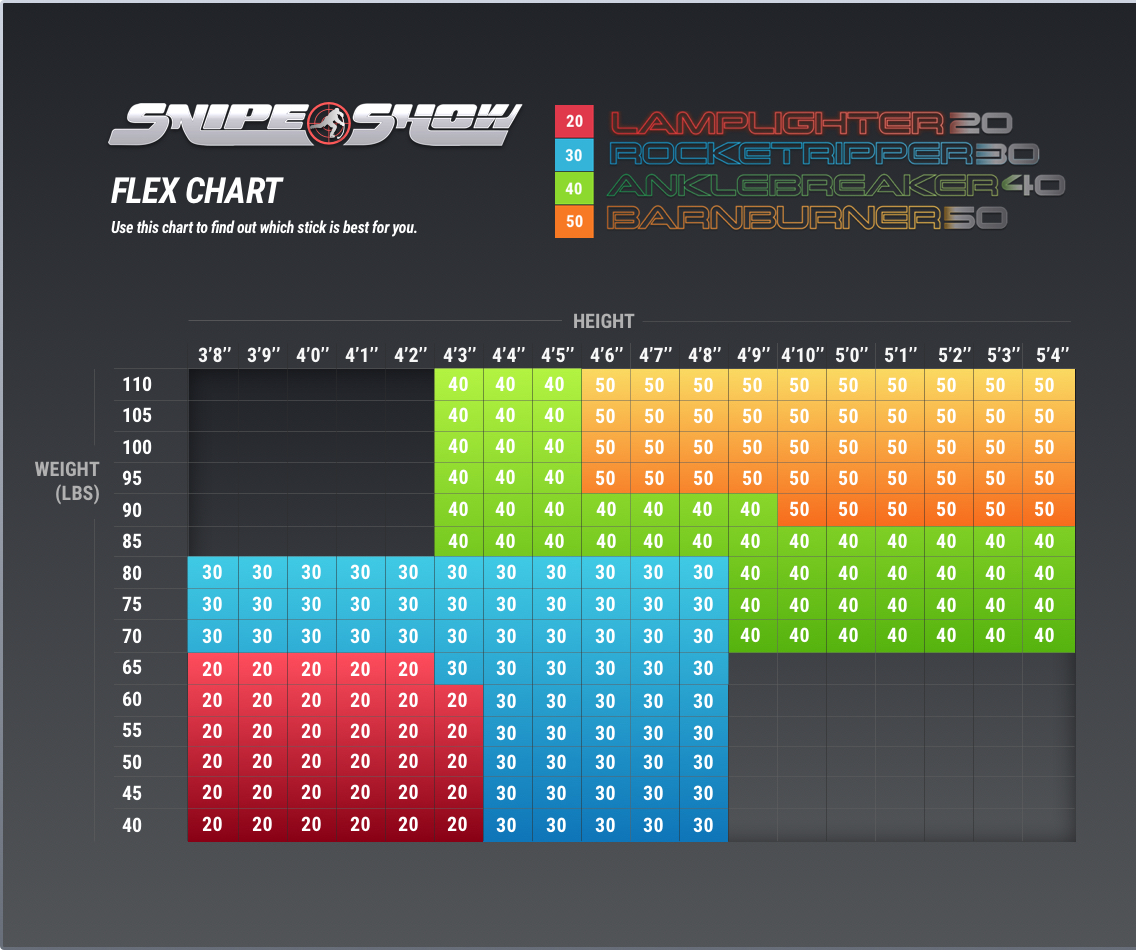A hockey stick flex chart helps players choose the right stick flex based on their weight and playing style. It ensures optimal performance and shot power.
Choosing the right hockey stick flex is crucial for performance. The flex rating indicates how much the stick bends when force is applied. Players should match their stick flex to their weight and playing style. A stiffer flex offers more control for heavier players, while a more flexible stick provides better puck handling and shot accuracy for lighter players.
Understanding the flex chart can significantly improve gameplay. This guide helps players select the perfect flex for their needs, enhancing their overall performance on the ice.
Credit: hockeyworldblog.com
Introduction To Hockey Stick Flex
Hockey stick flex is crucial for every player. It influences your shot power and accuracy. Understanding stick flex can enhance your game.
Importance Of Flex
The flex rating of a hockey stick measures its stiffness. A lower flex number means the stick is more flexible, and a higher flex number means the stick is stiffer. Choosing the right flex depends on your playing style.
Here are some reasons why flex is important:
- Shot Power: A proper flex helps generate more power.
- Accuracy: The right flex improves shot accuracy.
- Control: Flex affects puck control and handling.
Impact On Performance
The correct flex can enhance your performance on the ice. Here’s how:
- Quick Shots: A flexible stick allows for quick wrist shots.
- Slap Shots: A stiffer stick benefits slap shots.
- Stick Handling: Flex affects your ability to handle the puck.
Using the right flex for your weight and height is essential. Below is a simple flex chart to guide you:
| Player Weight (lbs) | Recommended Flex |
|---|---|
| Up to 100 | 30-40 |
| 101-150 | 50-60 |
| 151-200 | 70-85 |
| 201 and above | 90-100+ |
Refer to this chart to find your perfect flex. It can make a huge difference in your game.
Credit: www.reddit.com
Understanding Flex Ratings
Choosing the right hockey stick can significantly impact your game. One crucial aspect is the flex rating, which determines how much the stick bends under pressure. Let’s explore the concept of flex ratings further.
What Is A Flex Rating?
The flex rating measures the stiffness of a hockey stick. It indicates how much force is needed to bend the stick one inch. For example, a stick with a flex rating of 85 requires 85 pounds of force to bend an inch. The flex rating is essential as it affects your shot power and control.
Common Flex Ratings
Hockey sticks come in various flex ratings. Here are the most common ones:
| Flex Rating | Player Type |
|---|---|
| 40-50 | Youth players |
| 55-70 | Junior players |
| 75-85 | Intermediate players |
| 90-110 | Senior players |
Understanding these ratings helps you choose the right stick. A higher flex rating means a stiffer stick, which suits players with a stronger shot. A lower flex rating means more flexibility, which suits players who need more control.
Choosing The Right Flex
Choosing the right flex for your hockey stick is crucial. It impacts your game performance, including shot accuracy and puck control. The right flex depends on various factors such as player position, skill level, and personal preference. Understanding these factors can significantly enhance your game.
Player Position Considerations
Your position on the ice can influence the flex you need. Different positions require different flex characteristics:
| Position | Recommended Flex |
|---|---|
| Forward | Lower flex for quick shots |
| Defense | Higher flex for powerful shots |
| Goalie | Specialized flex for better control |
Skill Level Factors
Your skill level also affects the flexibility of your choice. Beginners usually benefit from a different flex compared to advanced players:
- Beginners: Softer flex for better puck feel and control
- Intermediate: Medium flex for balanced performance
- Advanced: Stiffer flex for powerful shots and passes
Remember, the right flex can improve your play significantly. Choose wisely based on your position and skill level.
Credit: twitter.com
Measuring Stick Flex
Understanding the flex of a hockey stick is crucial for players. Measuring stick flex helps you choose the right stick for your game. It can improve your shots and passes.
Flex Testing Methods
There are different methods to test the flex of a hockey stick. Each method provides a unique perspective.
- Machine Testing: Machines apply consistent pressure and measure flex accurately.
- Manual Testing: Players can manually bend the stick to feel the flex.
- On-Ice Testing: Real-game scenarios help in understanding the stick’s performance.
Machine testing is the most precise. It uses advanced technology. Manual testing is simple but subjective. On-ice testing is practical but varies from player to player.
Diy Flex Measurement
You can measure the stick’s flex at home. Here’s a simple method:
- Place the stick horizontally on two supports.
- Apply a weight (e.g., 20 pounds) at the center.
- Measure the bend in inches or centimeters.
A table can help in converting measurements to flex ratings:
| Weight Applied (lbs) | Bend Measurement (inches) | Flex Rating |
|---|---|---|
| 20 | 1.0 | 85 |
| 20 | 1.5 | 75 |
| 20 | 2.0 | 65 |
This DIY method is easy and requires minimal tools. By understanding stick flex, you can improve your game with the right equipment.
https://www.youtube.com/watch?v=
Adjusting Flex For Performance
Understanding the hockey stick flex chart is crucial for players. The right flex impacts your performance on the ice. Adjusting your stick’s flex can enhance your shot accuracy and power.
Cutting The Stick
Cutting the stick can change its flex. A shorter stick becomes stiffer. This increases control but reduces flexibility. To cut your stick:
- Mark your desired length with a marker.
- Use a saw to cut the stick.
- Smooth the edges with sandpaper.
Always cut small amounts at a time. Test the stick after each cut. This ensures you achieve the desired flex.
Using Extensions
Using extensions can also adjust the flex. Extensions make the stick longer. This increases flexibility and shooting power. Follow these steps to add an extension:
- Remove the end cap from your stick.
- Insert the extension into the stick’s end.
- Secure the extension with tape or glue.
Could you check the flex after adding the extension? This makes sure it meets your performance needs.
Adjusting your stick’s flex can greatly impact your game. Use these methods to find your perfect flex.
Credit: reboothockey.wordpress.com
Popular Flex Choices By Pros
Hockey sticks come in various flex ratings, which influence a player’s shot power and accuracy. Professional players often have specific stick flex preferences. Let’s explore these popular choices.
Nhl Player Preferences
Many NHL players prefer a flex that matches their playing style. Forwards usually choose a lower flex rating. This gives them a quick release and better puck control. Defensemen often opt for higher flex ratings. This helps them with powerful slap shots and long passes.
| Player | Position | Flex Rating |
|---|---|---|
| Connor McDavid | Forward | 85 |
| Shea Weber | Defenseman | 110 |
| Auston Matthews | Forward | 70 |
| Victor Hedman | Defenseman | 95 |
Trend Analysis
Over the years, there has been a shift in flex choices. Younger players tend to use lower flex ratings due to the fast-paced nature of modern hockey. They need sticks that allow quick shots and agile movements. On the other hand, seasoned players often stick to higher flex ratings. They rely on their strength and experience to maximize their shot power.
- Lower flex ratings (70-85) are popular among forwards.
- Defensemen favor higher flex ratings (95-110).
- Younger players prefer lower flex for agility.
- Seasoned players use higher flex for powerful shots.
The trend shows a clear division based on position and experience. Understanding these preferences can help amateur players make better choices. They can select the right flex that suits their style and improves their game.
Impact Of Flex On Shooting
The flex of a hockey stick greatly affects shooting performance. Flex determines how much the stick bends during a shot, influencing the power and accuracy of your shots. Understanding the impact of flex can help you choose the right stick for your game.
Slap Shots
Slap shots require a lot of power. A stiffer flex is beneficial for these shots. Here’s why:
- A stiffer flex means less bend in the stick.
- Less bend translates to more energy transfer.
- This results in a harder, more powerful shot.
Players who take a lot of slap shots often choose a stick with a stiffer flex. This allows them to maximize their shot speed and power.
Wrist Shots
Wrist shots rely more on precision than power. A softer flex can enhance these shots. Here’s how:
- A softer flex allows more bend in the stick.
- More bend helps in loading the stick with energy.
- This results in a quicker release and better accuracy.
Players who focus on wrist shots often prefer a stick with a softer flex. This helps them achieve better control and accuracy in their shots.
| Shot Type | Recommended Flex | Benefits |
|---|---|---|
| Slap Shots | Stiffer Flex | More power and speed |
| Wrist Shots | Softer Flex | Better control and accuracy |
Choosing the right flex can significantly improve your game. It’s important to consider your shooting style. Whether you favor slap shots or wrist shots, the right flex will help you perform better on the ice.
Caring For Your Stick
Caring for your hockey stick is crucial for its longevity and performance. A well-maintained stick can make a difference in your game. You can just read on to learn how to prevent damage and maintain performance.
Preventing Damage
Preventing damage to your hockey stick is essential. Follow these steps to keep your stick in great shape:
- Avoid hard surfaces: Do not use your stick on concrete or asphalt.
- Store properly: Keep your stick in a dry place, away from extreme temperatures.
- Use tape: Wrap the blade and handle with hockey tape to protect from wear and tear.
Maintaining Performance
Maintaining your stick’s performance ensures you play your best. Here are some tips:
- Check for cracks: Inspect your stick regularly for any cracks or damage.
- Re-tape as needed: Replace the tape on the blade and handle when it shows signs of wear.
- Keep it clean: Wipe down your stick after each game to remove dirt and moisture.
By following these tips, you can enjoy a longer-lasting, better-performing hockey stick.
Frequently Asked Questions
What Should My Flex Be For My Hockey Stick?
Choose a hockey stick flex that is half your body weight. For example, 80 lbs body weight equals a 40 flex stick.
What Does 65 Flex Mean Hockey Stick?
A 65-flex hockey stick means it takes 65 pounds of force to bend the stick one inch. Suitable for younger or smaller players.
What Flex Stick Do Most NHL Players Use?
Most NHL players use sticks with a flex rating between 85 and 100. This range offers a good balance of power and control.
What Is The Difference Between 85 And 95 Flex Sticks?
An 85 Flex stick is more flexible, offering better control and easier puck handling. A 95 Flex stick is stiffer, providing stronger shots and more power.
Conclusion
Choosing the right hockey stick flex can improve your game. The flex chart simplifies this decision-making process. Match your flex to your playing style for optimal performance. Remember, the right flex leads to better shots and control. Use this guide to find your perfect match and elevate your hockey skills.








